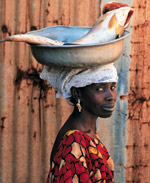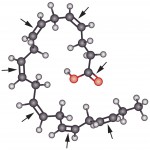
The goodness in fish
Taurine, selenium & other essentials
Compared with the world cereal harvest of around 2.2 billion tonnes per annum, the total global fish and seafood production of around 140 million tonnes seems very modest. Nevertheless fish is extremely important for human nutrition. It not only contains healthy protein but also many nutrients that do not occur in such quantity and diversity either in cereals or other crops or in meat. So fish makes an essential contribution to a healthy diet. Its most important constituents include proteins, certain fatty acids, vitamins and minerals. The specific nutrients supplied by fish include:- low-fat muscle meat containing 15 to 20 per cent protein, in the case of lean fish like pollock, cod or haddock;
- large quantities of unsaturated fatty acids, particularly omega-3 fatty acids, in the case of fatty fish like salmon and mackerel;
- iodine;
- selenium, a chemical element that is an important component of proteins. Proteins containing selenium can intercept free radicals and are thought to prevent cancer;
- taurine, a metabolite product of protein that is important for the development of the brain and retinal tissue. Moreover it plays a key role in the development of cell membranes and in the detoxification of the body;
- vitamin D, which very few foods contain in worthwhile amounts. Vitamin D mainly occurs in fatty fish;
- niacin, vitamin B6 and vitamin B12;
- all the important amino acids for human nutrition, including those known as “essential amino acids” which the human metabolism cannot synthesize itself.
- 2.7 > Fish consumption in 2009, by region and development status. Viewed in terms of continents alone, Asia leads the world in total consumption

- Whereas average fish consumption in the 1960s was 9.9 kilograms, by 2010 annual per-capita consumption had risen to 18.6 kilograms. But fish consumption varies massively from country to country depending on local traditions and supplies. Fish is especially important in many developing countries because it is often the only afford-able and relatively easily available source of animal protein. In Bangladesh, Cambodia and Ghana, for instance, around 50 per cent of animal protein is supplied by fish. Often it is the only source of numerous other important nutrients, too. In many African countries south of the Sahara, the people traditionally make little use of fish – in Congo, Gabon or Malawi, for example – although fish could actually make a substantial contribution to human nourishment. In the year 2009, fish supplied 16.6 per cent of the total worldwide consumption of animal protein and 6.5 per cent of total protein, i.e. animal and plant protein combined.
- 2.8 > In the industrialized nations fish is mainly bought and sold deep-frozen (2010). Sophisticated cooling chains make this possible. The fish often comes from offshore fisheries and is landed frozen prior to onward distribution. In developing countries fish is predominantly bought and sold alive or fresh. In some cases it is chilled during transportation.

Smoked, fresh or frozen?
Fish and seafood are traded and transported in different forms around the world. For 2010 the proportions were as follows:- live, fresh or chilled: 46.9 per cent;
- deep-frozen: 29.3 per cent;
- prepared and preserved: 14.0 per cent;
- smoked, dried, cured: 9.8 per cent.
 2.9 > Long fatty acid molecules like DHA consist primarily of carbon (dark grey) and hydrogen (light grey). Fatty acids are unsaturated if carbon atoms are linked by double bonds because they are missing hydrogen atoms.
2.9 > Long fatty acid molecules like DHA consist primarily of carbon (dark grey) and hydrogen (light grey). Fatty acids are unsaturated if carbon atoms are linked by double bonds because they are missing hydrogen atoms.- Variations in these percentages depend on region and on consumer behaviour. Many developing countries lack the infrastructure to be able to transport chilled or deep-frozen fish to all customers. Fish is mainly offered on the coast or beside large lakes, directly where it has been caught. In other parts of the country the use of fish is far less widespread. In industrialized countries, on the other hand, the vast bulk of fish is sold as a deep-frozen product and is generally imported nowadays. To a lesser extent, fish is eaten smoked, salted or marinated in these countries. Some seafood like oysters are even eaten alive. In the year 2010 around 20 million tonnes of fish and seafood were utilized in the non-food segment. The vast majority of this was processed into fishmeal and fish oil, predominantly for use in aquaculture. Furthermore, fish and seafood or extracts derived from them are used in the manufacture of cosmetics and medicines. Over the past 20 years the cosmetics and pharmaceuticals industries have increasingly recognized fish wastes as a valuable resource. In the past these waste products were simply disposed of. Today they are quite matter-of-factly used in production.
Cereal in place of fish fillet?
Critics emphasize that people should refrain from consuming fish so as to conserve fish stocks and the marine environment. Their opponents argue that there are hardly any alternatives; virtually no other food is a substitute for the unique combination of nutrients in fish. This applies particularly to the nourishment of people in developing countries, for whom alternative foods are unaffordable or quite simply unavailable. It would also be difficult to replace the full amount of fish and seafood, some 140 million tonnes, entirely with plant-based foodstuffs. Ultimately wild fish and seafood are organically generated foods whose growth depends solely upon the photosynthesis carried out by phytoplankton. By contrast, most vegetable or cereal production requires the use of fertilizers and plant protection products. In addition, large areas of land are necessary for arable farming, some of which can only be obtained by destroying natural habitats. The amount of land area needed to replace the worldwide total marine catch of around 80 million tonnes of wild fish and seafood can only be roughly estimated, partly because protein content or nutritional value varies from one fish species to another and from one crop to another, and partly because the fertility of different soils varies enormously. Based on the assumption of cereal farming on averagely productive soils, worldwide it would take an area of land at least the size of France to match the nutritional value of the global wild fish catch. It is clear, however, that the worldwide fishing industry does need to be converted to the sustainable management of fish stocks.
